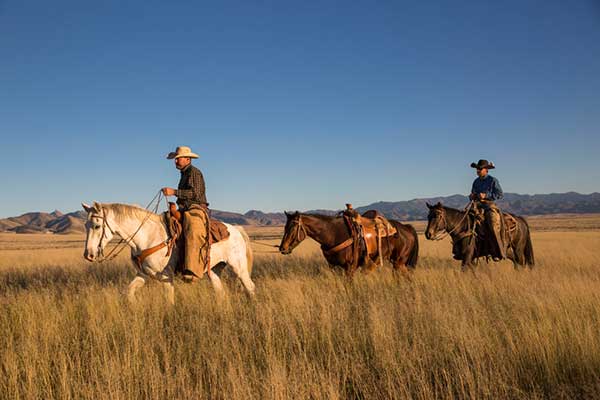Trust for Public Land and New Mexico Land Conservancy have protected more than 27,000 acres of the Cienega Ranch with conservation easements to safeguard from future development
WILLCOX, Ariz. — Trust for Public Land (TPL) announced today that 7,852 acres of the Cienega Ranch has been protected through the purchase of a conservation easement from the ranch owner. The ranch is located near the Willcox Playa, location of the hugely popular annual Wings over Willcox birding and nature festival and the main destination for the 30,000 sandhill cranes that winter in Arizona.
This latest project will increase the total grasslands on this ranch that have been permanently protected by TPL and our partners to over 27,000 acres.
“The grasslands in this valley where Cienega Ranch is located contains critical habitat for endangered wildlife, and also supports large working cattle ranches for America’s food supply and provides substantial amounts of carbon storage to help mitigate climate change,” said Michael Patrick, Senior Project Manager for Trust for Public Land. “This conservation victory means that Cienega’s rich ecosystem can flourish and thrive, cultivating healthy grasslands for years to come.”
Cienega Ranch lies in the Southern Sulphur Springs Valley just northwest of the Chiricahua Mountains, which form the eastern boundary of the valley and are the largest of the “Sky Island” mountain ranges in the United States.
The project will conserve high-quality native grasslands and critical wildlife habitat, while keeping the land as a working cattle ranch. The protected land is immediately adjacent to important public lands such as Fort Bowie National Historic Site and the Bowie Mountain Scenic Area of Critical Environmental Concern.
The owner of Cienega Ranch, Josiah Austin, is working on a long-term effort to protect and improve the ranch’s grasslands for both wildlife and cattle ranching. Techniques Austin has developed to retain water and prevent erosion are being used to restore other ranchlands across the Southwest. Austin intends to use the proceeds from the sale of the conservation easement for more land restoration projects and land protection in the valley.
His work on wildlife projects with government partners and organizations like Arizona Game and Fish and National Wild Turkey Federation has also included the reintroduction of the Gould’s turkey to the Chiricahua Mountains and of a number of endangered species – such as Gila topminnow and Chiricahua leopard frog – in ponds and stocktanks on Cienega Ranch. A rare jaguar sighting has also been documented crossing his ranch.
“This whole valley contains some spectacular grassland that is home for birds, bats, jaguar, deer and, of course, cattle,” says Josiah Austin, owner of Cienega Ranch. “I hope people understand that keeping land like this in ranching is one of the best options for our society to keep those open spaces and protect the wildlife that rely on this country. It is really important to me that Cienega and HYL Ranches stay wild and undeveloped in the future, and I am happy to have placed this conservation easement on the land. I would like to thank all the amazing partners that have helped me over the years with projects to restore these grasslands, help with wildlife projects, and now permanently protect the ranch.”
The conservation easement on the property means Austin will continue to own and work the land, but it will never be subdivided or developed. New Mexico Land Conservancy, a partner land trust which holds 120 conservation easements on ranches in New Mexico and Arizona, will monitor the ranch every year in perpetuity to ensure the terms of the conservation easement are being followed by the landowner.
Funds to acquire the conservation easement came from the Natural Resource Conservation Service (an agency of the U.S. Department of Agriculture), an anonymous donor, Malpai Borderlands Group, and The Nature Conservancy of Arizona.
“The work that Josiah Austin is doing to protect contiguous ranchlands from development is extraordinary. It will not only keep grasslands open to ranching but enhance the biodiversity while improving ranchlands”, according to a generous donor to the project.
“The Malpai Borderlands Group decided to get involved in this project because it supports all the same values that the Malpai Group stands for: sustaining wild, working landscapes by helping ranchers protect their private lands,” says Rich Winkler, executive director of the Malpai Group.
“Not only does this collaborative project protect one Arizona’s remaining native grassland landscapes and an important wildlife corridor in the Sky Island region, but it also exemplifies the critical role a private landowner and rancher can play in conserving our state’s lands and biodiversity,” said Jody Norris, Director of Land & Water Protection for The Nature Conservancy Arizona. “Projects like this represent what is possible when a private landowner, government agencies, and the conservation community come together to support shared goals that benefit both people and nature.”
About Trust for Public Land
Trust for Public Land (TPL) is a national nonprofit that works to connect everyone to the benefits and joys of the outdoors. As a leader in equitable access to the outdoors, TPL works with communities to create parks and protect public land where they are needed most. Since 1972, TPL has protected more than 3 million acres of public land, created more than 5,000 parks, trails, schoolyards, and iconic outdoor places, raised $84 billion in public funding for parks and public lands, and connected more than 9 million people to the outdoors. To learn more, visit tpl.org.









